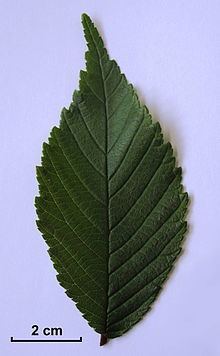Scientific name Ulmus uyematsui | Genus Ulmus Rank Species | |
 | ||
Similar Ulmus bergmanniana, Ulmus microcarpa, Ulmus changii, Ulmus castaneifolia, Ulmus chenmoui | ||
Ulmus uyematsui , commonly known as the Alishan elm, is endemic to forests at elevations of 800–2,500 metres (2,600–8,200 ft) in Alishan, Chiayi County [3], central Taiwan, where it is considered one of the minor tree species. The tree was first named and described by the Japanese botanist Bunzō Hayata in 1913, in the aftermath of the First Sino-Japanese War, when Formosa (now Taiwan) was ceded to Japan.
Contents
Description
The tree grows to a height of 25 m with a d.b.h. to 80 cm. The bark is grey, longitudinally fissured, and exfoliates in irregular flakes. The branchlets are brown, glabrous, though pubescent when young, and devoid of corky wings. The largely glabrous leaves are elliptic to oblong-elliptic 5–11 × 3–4.5 cm wide, typically caudate at the apex; the margins are doubly serrate [4]. Unlike most elms, the leaves are equal at the base, have short (2–6 mm) petioles, and are flushed dark-red on emergence. The perfect wind-pollinated apetalous flowers appear on second-year shoots in February, the obovate to orbicular samarae, 10–15 × 8–10 mm, in March.
Hayata considered the tree similar to Ulmus castaneifolia, differing only in the much thinner leaves, and absence of pubescence on the axils of the primary lateral veins.
Pests and diseases
No information available.
Cultivation
U. uyematsui is rare in cultivation beyond Taiwan; it was introduced to commerce in the Netherlands in 2011. U. uyematsui was selected as one of eight tree species considered hardy enough to survive in the ecological reclamation of the Wujiazi iron mine 270 kilometres (170 mi) north-east of Beijing in Liaoning Province, China, where winter temperatures fall as low as −20 °C (−4 °F). In England the species has survived temperatures as low as −16 °C (3 °F), but has succumbed to prolonged waterlogging on clay soils overwinter.
Etymology
The species is named for K. Uyematsu, who collected the plant in 1913.
